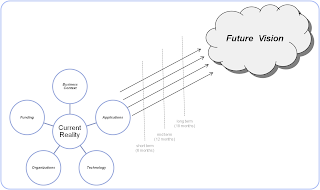 It is good to document the the as-is (or current reality) from all the domains such as Business Context, Applications, Technology, organization and Funding. Typically the business context is best understood by identifying and mapping the key business processes at a high-level.
It is good to document the the as-is (or current reality) from all the domains such as Business Context, Applications, Technology, organization and Funding. Typically the business context is best understood by identifying and mapping the key business processes at a high-level.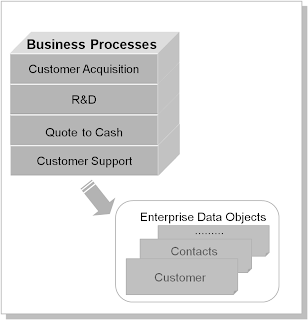 This approach not only helps have a common vocabulary between business and IT by identifying the key business processes, it also helps identify the key enterprise data objects (entities) such as Customers, Contacts, Products and orders. Based on the priorities of the each of the business process, the next steps would be to drill down into one or all the business processes as illustrated below.
This approach not only helps have a common vocabulary between business and IT by identifying the key business processes, it also helps identify the key enterprise data objects (entities) such as Customers, Contacts, Products and orders. Based on the priorities of the each of the business process, the next steps would be to drill down into one or all the business processes as illustrated below. Once again, it is not necessary to use a Business Process Modeling tool (however, using one would be helpful later), the objectives is to clearly identify and document the next level of details. The next steps are to perform the gap analysis on each of the activities as illustrated below.
Once again, it is not necessary to use a Business Process Modeling tool (however, using one would be helpful later), the objectives is to clearly identify and document the next level of details. The next steps are to perform the gap analysis on each of the activities as illustrated below.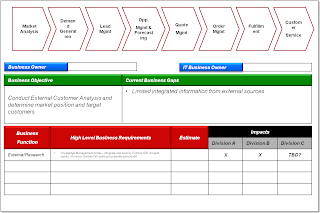 This approach enables both business and IT clearly visualize the existing gaps, impact areas and cost estimates which helps in developing the priorities and the investment plan. In addition, it is also important to identify and illustrate the list of applications/solutions that support a given business process as well as it perception within Business and IT as illustrated below.
This approach enables both business and IT clearly visualize the existing gaps, impact areas and cost estimates which helps in developing the priorities and the investment plan. In addition, it is also important to identify and illustrate the list of applications/solutions that support a given business process as well as it perception within Business and IT as illustrated below.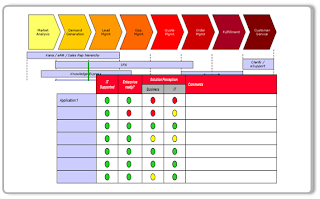 As we develop the actionable road map to the future state, one this is obvious, no matter what we implement or adopt, whether it is a packaged applications, BPM or SOA key enterprise data crosses the silos both from an organization and the applications. It is for this reason, there is a critical need for adoption Master Data Management across the enterprises.
As we develop the actionable road map to the future state, one this is obvious, no matter what we implement or adopt, whether it is a packaged applications, BPM or SOA key enterprise data crosses the silos both from an organization and the applications. It is for this reason, there is a critical need for adoption Master Data Management across the enterprises.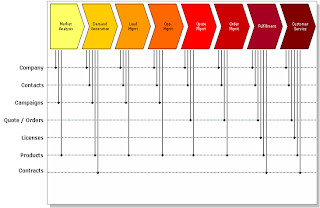 It is very important to spend sometime understanding and mapping these enterprise data objects in the context of the business process. It would also be very helpful to also develop a high-level data model and transaction (CRUD) matrix associated with the business process before initiating the activity of selecting/implementing an MDM solution.
It is very important to spend sometime understanding and mapping these enterprise data objects in the context of the business process. It would also be very helpful to also develop a high-level data model and transaction (CRUD) matrix associated with the business process before initiating the activity of selecting/implementing an MDM solution.I have seen a lot examples where companies have embarked on an MDM project without developing the architecture (see my blog on Blueprinting Information Architecture for more details) and not meeting the desired business outcome. The two other primary reasons of MDM failures are:
- Lack of developing the data governance model up front that involves all the impacted business units
- Assuming that a packaged applications could be modified to be the master data for enterprise.
As usual please do feel free to drop me line with your comments and/or feedback.
- Yogish
1 comment:
Thank you for sharing. Master data management is the lifeblood of all applications.
Post a Comment